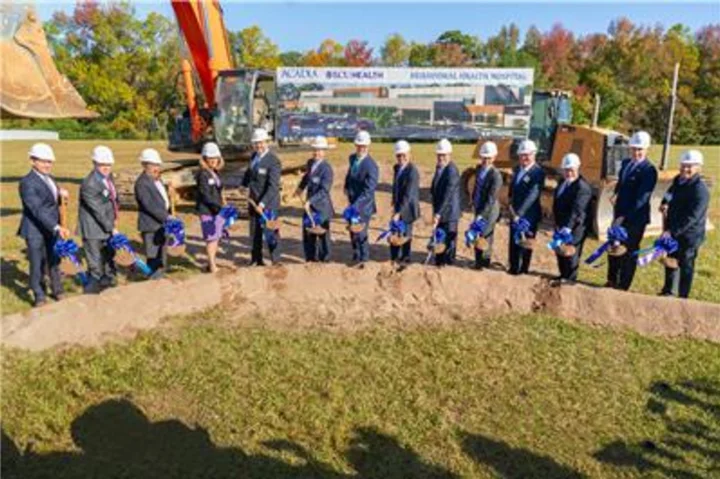DALLAS--(BUSINESS WIRE)--Sep 19, 2023--
Colossal Biosciences (“Colossal”), the world’s first de-extinction company, and BioRescue, a consortium initiating and leading the scientific rescue mission of the northern white rhino employing advanced assisted reproduction technologies and stem cell associated techniques, have teamed up to save the northern white rhino from extinction. The partnership will also develop a roadmap for future rescue missions of endangered species using the world leading expertise of both organizations. Together they will work to improve, develop, and implement strategies in the fields of wildlife conservation research and wildlife veterinary medicine, providing approaches to reduce the sixth mass extinction.
This press release features multimedia. View the full release here: https://www.businesswire.com/news/home/20230919136056/en/
Fatu in front and Najin in back are the last two known northern white rhinos alive on the planet. They live at Ol Pejeta conservancy in Kenya. (Photo by Ami Vitale)
The northern white rhino ( Ceratotherium simum cottoni ) is considered to be functionally extinct in the wild as a direct result of poaching. Its natural habitats include parts of Uganda, Chad, Sudan, the Central African Republic and the Democratic Republic of Congo. All these areas were completely emptied out of this charismatic megavertebrate more than a decade ago. The only two living females were born in the Czech ZOO Dvůr Králové and are being cared for at Ol Pejeta Conservancy in Kenya since 2009.
Prof. Dr. Thomas Hildebrandt, Project Head at BioRescue, Head of the Department of Reproduction Management of the Leibniz Institute for Zoo and Wildlife Research, and Member of the Scientific Advisory Board of Colossal, has spent over 25 years on a mission to save the northern white rhino species. He has led the efforts with BioRescue to convey how synthetic biology can be used in addition to the genetic rescue techniques that are already in place. “The northern white rhino is the world’s rarest large mammal and thousands of species are interlinked to its existence,” says Hildebrandt. “With Colossal’s advanced genetic technology, we will be able to piece together the missing links of the species’ genetic history. Following decades of assisted reproduction and stem cell innovations made by scientists and conservationists, I’m thrilled that the partnership between Colossal and BioRescue will help to establish a sustainable and genetically robust northern white rhino population.”
The new partnership will assess the genetic diversity of the northern white rhino ( Ceratotherium simum cottoni ) in historic samples as the basis for ethically evaluated decisions on possibly enhancing the genetic variability of a future northern white rhino population. This groundbreaking conservation strategy is accompanied by exemplary transparency of the project’s undertakings to the general public.
The Science Behind the Conservation
Colossal will assist the rescue mission by leveraging genome sequencing and gene editing methods to save the endangered species. The focus on the edits will be to improve genetic diversity in living cells and mitigate impacts of disease or lost adaptability to the changing climate.
- Sequencing: The partnership will generate a global catalog of museum samples of northern white rhino specimens from the past, including bones, dry skin, and preserved organs and fetuses, which can be used to extract ancient DNA. The partners will then obtain preserved samples in order to sequence all suitable samples and study the genetic diversity of the species.
- Genetic Editing: Once loss to gene pools has been identified in preserved specimens, Colossal will use the identified sequences as targets to restore the lost diversity into cell lines that will be used to produce northern white rhino embryos.
- Population Study: The team will conduct a population study of genetic diversity of the southern white rhino ( Ceratotherium simum simum ) which is the sister taxon of the northern white rhino to identify key aspects of a healthy population. Colossal will leverage FormBio, its technology spinoff, to complete this study. FormBio’s comparative genomic tool allows scientists to compare the DNA and genome of the specimens to the northern white rhino population we have today and identify genetic diversity that existed before the massive decline of the species.
“We’re very honored to be BioRescue’s genetic rescue partner and thus have the opportunity to help save the northern white rhino, as well as other iconic keystone species from the brink of extinction,” says Ben Lamm, CEO and Co-Founder of Colossal. “At Colossal we’re passionate about species preservation and as part of our larger de-extinction work, we want to leverage our techniques and toolkit for conservation. We are creating tools that will allow us to heal what has been lost and restore ecosystems that will be sustainable for future generations.”
The Conservation Paradox
The rate at which species loss is occurring is significantly faster than the restoration efforts of the classical conservation approaches. Between now and 2050, humanity will lose up to 50% of all biodiversity if nothing changes. The vast majority of conservation efforts are focused on preserving landscapes and ending poaching. But, with only two remaining northern white rhinos, the need to add more advanced technologies to preserve the taxon becomes apparent. In order to stop the loss, there is a need for new tools and technologies. The partnership is developing these tools to improve the capacity of the conservation ecosystem.
“We're really thankful to Prof Dr. Hildebrandt and BioRescue for trusting us as a partner to provide de-extinction technologies for the rescue of the northern white rhino,” says Matt James, Head of Conservation and Colossal’s Chief Animal Officer. “De-extinction is an engine of innovation that leads to tools that are directly applicable to conservation. Together, with some of the leading people in their fields, we will successfully be able to address and remedy specific conservation problems - starting with the northern white rhino.”
Colossal and BioRescue’s partnership is the starting point for future modern conservation networks which will help improve international conservation and conservation research organizations.
“The BioRescue Consortium is a unique model of extensive international cooperation that involves top scientists from Germany, Japan and Italy, conservationists in the field in Africa as well as zoo experts from Europe. This new partnership with Colossal transforms existing conservation approaches to a new level and can serve as a blueprint for other international efforts to save endangered species,” says Jan Stejskal, Director of International Projects at Dvůr Králové and coordinator of efforts to save the northern white rhinos.
Colossal’s Conservation Toolkit
Colossal’s conservation toolkit is a set of resources the company employs to help partner organizations preserve and save species at-risk. The company utilizes its expertise to preserve lost genetic diversity and create the hardware necessary for species rebirth and restoration to improve today’s conservation efforts. Now, Colossal will also provide these services as the
genomic arm of BioRescue.
ABOUT COLOSSAL BIOSCIENCES
Colossal was founded by emerging technology and software entrepreneur Ben Lamm and world-renowned geneticist and serial biotech entrepreneur George Church, Ph.D. Colossal creates disruptive technologies for extinct species restoration, critically endangered species protection and the repopulation of critical ecosystems that support the continuation of life on Earth. Colossal is accepting humanity’s duty to restore Earth to a healthier state, while also solving for the future economies and biological necessities of the human condition through cutting-edge science and technologies. To follow along, please visit: www.colossal.com
ABOUT BIORESCUE
The BioRescue Consortium combines assisted reproduction technologies (ART) and stem cell associated techniques (SCAT) to save the northern white rhino from extinction. With the support of international partners the consortium aims to develop new scientific conservation approaches to preserve keystone and umbrella species. This will lead to blueprints which can be used in by conservation initiatives worldwide to halt the loss of biodiversity and preserve ecosystem services for future generations. The Consortium is led by German the Leibniz Institute for Zoo (Leibniz-IZW). Consortium members: Leibniz-IZW, the ZOO DVůR KRÁLOVÉ (Czech Republic), Avantea (Italy), Max Delbruck Centre for Molecular Medicine (Germany), Osaka University (Japan), and Padua University (Italy). www.BioRescue.org
ABOUT LEIBNIZ INSTITUTE FOR ZOO AND WILDLIFE RESEARCH
The Leibniz-IZW is an internationally renowned German research institute of the Forschungsverbund Berlin e.V. and a member of the Leibniz Association. Our mission is to examine evolutionary adaptations of wildlife to global change and develop new concepts and measures for the conservation of biodiversity. To achieve this, our scientists use their broad interdisciplinary expertise from biology and veterinary medicine to conduct fundamental and applied research – from molecular to landscape level – in close dialogue with the public and stakeholders. Additionally, we are committed to unique and high-quality services for the scientific community. www.izw-berlin.de
ABOUT ZOO DVůR KRÁLOVÉ
ZOO Dvůr Králové is a safari park in the Czech Republic. It’s one of the best rhino breeders outside of Africa and the only place where the northern white rhino bred in human care - both remaining females, Najin and Fatu, were born here. ZOO Dvůr Králové coordinates efforts to save the northern white rhinos. https://safaripark.cz
WEBSITE & SOCIALS
Websites: www.colossal.com, www.vertebrategenomesproject.org
Twitter: https://twitter.com/ItIsColossal, https://twitter.com/genomeark
Instagram: https://www.instagram.com/itiscolossal/
LinkedIn: https://www.linkedin.com/company/itiscolossal/
Facebook: https://www.facebook.com/ItIsColossal
Hashtag: #ItIsColossal
View source version on businesswire.com:https://www.businesswire.com/news/home/20230919136056/en/
CONTACT: Colossal BioSciences
Emily.mailaender@rcpmk.com
pro-colossal@prosek.comLeibniz Institute for Zoo and Wildlife Research (Leibniz-IZW)
Steven Seet
Head of Science Communication
Phone: +491778572673
E-mail:seet@izw-berlin.deZOO Dvůr Králové
Jan Stejskal
Director of Communication and International Projects
Phone: +420608009072
E-mail:jan.stejskal@zoodk.cz
KEYWORD: TEXAS AFRICA EUROPE UNITED STATES NORTH AMERICA
INDUSTRY KEYWORD: RESEARCH ENVIRONMENTAL POLICY ENVIRONMENTAL ISSUES ANIMAL WELFARE ENVIRONMENT GENETICS HEALTH TECHNOLOGY SCIENCE BIOTECHNOLOGY CLIMATE CHANGE HEALTH PUBLIC POLICY/GOVERNMENT
SOURCE: Colossal Biosciences
Copyright Business Wire 2023.
PUB: 09/19/2023 04:00 AM/DISC: 09/19/2023 04:00 AM
http://www.businesswire.com/news/home/20230919136056/en









